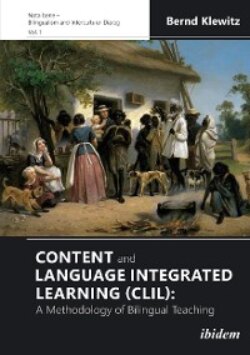Читать книгу Content and Language Integrated Learning (CLIL): A Methodology of Bilingual Teaching - Bernd Klewitz - Страница 11
1.6 The Unitary Language System Hypothesis
ОглавлениеIts predecessor models go back to scientists like Noam Chomsky and his Universal Grammar proposals that it was commonly thought that children learning two languages simultaneously during infancy go through a stage where they cannot differentiate their two languages. Bilingual children, in other words, mix elements from their languages regularly. The empirical basis of this assumption was re-examined in the 1990s (see above: Genesee study 1996) with the result that from the beginning bilingual children develop differentiated language systems and are able to use their developing languages in contextually sensitive ways. In this context it is important to remember that code-switching is not a sign of a strong language (L1) dominating the weak one (L2) or even leading to the aforementioned “macaronic language mix” (Meisel: 8, 58), but rather signifies the competence of bilinguals to choose their language according to who and why they are talking to, and in which situation.
Equally important is the possible role of parental input in the form of mixed utterances and its opposite, the “one person, one language” (OPOL) method. Since the beginning of research on bilingual development, which the bilingual guide book (Meisel: 86) situates in the middle 1910s, OPOL has played a major role. It has been modified much later, and in a German context, by the well-known “enlightened monolingualism approach” (Butzkamm: 2019 “Aufgeklärte Einsprachigkeit”) and is still an issue in both bilingual theory and CLIL strategies. Without science-based evidence, the OPOL approach is recommended because “this principle or method is based on common-sense considerations rather than reflecting insights into mechanisms underlying bilingual acquisition” (Meisel: 87). Accordingly, Meisel’s guide book does “not recommend mixing languages freely in child-directed speech” (ibid.: 118):
This is to say that adult interlocuters should make it a habit to adhere to one language in addressing the child, in accordance with the OPOL principle, keeping in mind, however, that it is a useful strategy, not a dogma. Language mixing or switching is thus not excluded, since there is no reason to be concerned about potential effects of mixed speech on bilingual acquisition. On the contrary, code-switching, inserting nouns from the other language, etc. can facilitate or even improve communication (ibid.: 118 f).
In how far the OPOL principle should also be applied to teaching CLIL programs, where the instructor needs to choose the appropriate strategy to scaffold the learning process, and ensure comprehensible input as well as maintain effective communication, would have to be considered separately. It is true that the question of mixing languages is not only a phenomenon in early childhood bilingualism but becomes even more relevant when looking at successive bilingualism as in CLIL. As far as the latter is concerned, the use of L1 and L2 in teaching situations is still a matter of contentious debate among researchers and instructors, whether supporting enlightened monolingualism or not, and will be dealt with in looking at the challenges and desiderata of bilingual teaching (see chapter 10).
Review—reflect—research
Compare the risks and benefits of childhood bilingualism.
Discuss the “experiment” of the young couple from Southern Germany. Would you bring up your children bilingually if given the opportunity? Why/why not?
Find out more about the debate of using L1/L2 in bilingual teaching programs. What is your inclination?
1 Some authors prefer the label “multiculturalism” in accordance with the European Commission to accommodate “Europe’s linguistic diversity” (cf. https://ec.europa.eu/education/education-in-the-eu/council-recommendation-improving-teaching-and-learning-languages_en. Last viewed 03/05/2021.).
